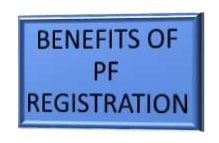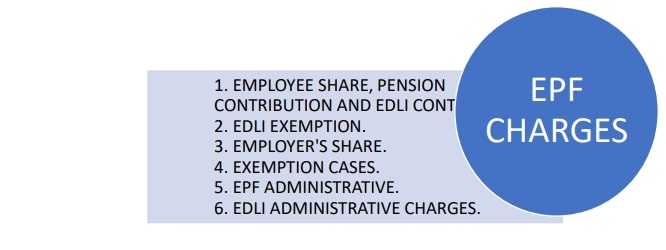
PF registration is a PROVIDENT FUND they are also related EPF (EMPLOYEE PROVIDENT FUND) registration under the spectrum of employee’s provident funds and miscellaneous act, 1952, one that employee provident fund organization undertake. EPF is charged in all those cases where there are 20 or more employees, while other organization employing less than 20 people also fit the criteria that would cater to exemptions and constraints. It is important to note that employer employer and employee contribute a portion of their salary, up to 12% along with the dearness allowance charged for EPF. This amount is then combined with the required interest and given to the employee once they retire. It is a combination of both the employee’s and employer’s contributions.

EMPLOYEE PROVIDENT FUND is one of the Government based incentive to uplift the retirement saving that benefits various employees. It is a must have for organizations with a required number of employees and bring the fourth various provisions for employees and employers all in all.

- Legal Compliance - EPF is one of the ways in which employers are made to fulfil their obligations to avoid any legal penalties.
- Tax Benefits - That the employers possess a clear understanding of the tax implications related to EPF contribution.
- Social Security - EPF registration holds immense importance in guaranteeing the wellbeing of employees.
- Employee Retention - EPF provisions are referred to as an essential incentive that invites or retains talented employees, serving as a benefit for the candidates.

- Loan Facilities - Employees provident fund registration not only provides financial backing but encourages the employees to avail of the loan facilities against their EPF balance for plenty of other reasons.
- Nomination Facilities - EPF acts as a boon in encouraging the employees to nominate their family members to become the beneficiaries in case of the demise of the PF holder.
- Retirement Savings - Retirement saving acts as financial backing and keeps you and your employees financially secure to a more significant extent.

- Cancelled Cheque.
- PAN Card of Firm/ Company/ Society/ Trust.
- Certificate of Incorporation or Registration.
- Consent of Majority of Employees in Case of Voluntary Registration.
- Address Proof of Premises.
- Signature Copy of Directors and Authorized Signatories.

- Passport
- Aadhar Card
- Voter ID
- Driving License

- Latest Bank Account Statement.
- Self-Attested Copy of Recent Telephone or Electricity Bill.

- Visit the website and click on the Establishment Registration button on the homepage.
- On the Establishment Registration home page of the EPFO website, the USSP (Unified Shram Suvidha Portal) sign-up page will open, and the employer needs to click the Sign-Up button.
- The employer needs to log in to the USSP and select the Registration for EPFO-ESIC button present on the left-hand side of the screen. Next, select the ‘Apply for New Registration’ button on the right side of the screen. Two options will appear: ‘Employees State Insurance Act 1948’ and ‘Employees Provident Fund and Miscellaneous Provision Act 1952.’ The employer will need to select the ‘Employees Provident Fund and Miscellaneous Provision Act, 1952’ and click the Submit button.
- Next, we clicking the Submit button, the Registration Form for EPFO page will open, and the employer needs to fill in the establishment details, contacts, contact person, identifiers, employment details, branch, and activities.
- After filling in the Registration Form for EPFO and attaching the relevant documents, the employer’s Digital Signature Certificate (DSC) is to be uploaded and attached to the form.
- DSC of the employer is uploaded, the employer will receive a successful completion message and an email from the Unified Shram Suvidha platform confirming that the EPFO registration has been completed.

- Uniform account
- Long term goals
- Emergency needs
- Risk coverage
- Deduction of TDS from employees requires EPF registration.
- Processing of remittances is only possible after generating challans through the EPFO employer portal.
- Employee deposit linked insurance scheme.



- XML file needs to be converted into a CSV file format before uploading it for return filing.
- Return filing must be filed online by the 15th of the following month.
- The return filing process involves making the necessary contribution through online payment gateways.
- The monthly filing of return is done through online establishment’s login by uploading the ECR sheet.
- ECR sheet can be obtained from EPFO as an XML file, containing the names and UANs of all employee’s registration.

Employers with 20 or more employees must register for PF, while smaller establishments can also register voluntarily to provide benefits to their employees.
Apply for PF registration through the online EPFO official website by filling out the necessary forms and submitting the required documents.
PF registration is mandatory for businesses with 20 or more employees. For businesses with fewer employees, it is optional but recommended.
TDS deducted from employees' salaries makes EPF registration a critical process for employers. Key benefits include:
- Risk Coverage
- Emergency Needs
- Uniform Account
- Long-term Goals
- Employee Pension Scheme
The employer forgets the user ID or password, they can click on the "Forgot Password" link in the login screen. The password can be reset using the establishment ID, primary email ID, or mobile number.
The employer can generate the employee UAN. In the event of a change of employer, EPF registration needs to file a regular monthly return on the 25th of every month, and one annual return before the 25th of April each year.
- 1. Up to 2 months: 5%
- 2. Two to four months: 10%
- 3. Four to six months: 15%
- 4. Beyond 6 months: 25%

